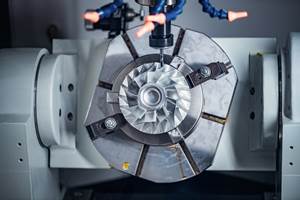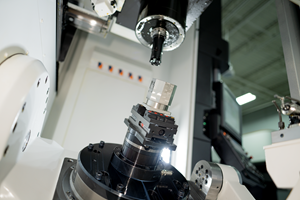(Text updated February 4, 2019) Ryan Pohl of Praeco Skills developed this test to quickly evaluate students' knowledge of CNC milling and drilling and determine the level of instruction they need. What is your level of knowledge? Scroll down to read the questions and find an answer key or take the quiz interactively here.
1. What is the maximum rpm you should run a holder if it is unbalanced in a V-tapered spindle?
__ 4,000 rpm
__ 6,000 rpm
__ 8,000 rpm
__ 10,000 rpm
2. Unless it has a special design to ensure Z-Axis accuracy, V-tapered tooling should never be run faster than…
__ 6,000 rpm
__ 8,000 rpm
__ 10,000 rpm
__ 12,000 rpm
3. Countless tests have proven which of the following tool tapers to be superior in radial and axial stiffness, z-axis repeatability and performance for high speeds?
__ CAT
__ HSK
__ BT
__ SK
4. You should never use a cutter that has _________________ in a hydraulic holder, a milling chuck or in high speed applications.
__ Weldon flats
__ Hybrid coatings
__ Multiple inserts
__ Through-spindle coolant
5. One of the key limiting factors of a C-frame mill design is…
__ Workpiece visibility
__ Top-end rpm
__ Tool-magazine capacity
__ Y-axis rigidity
6. What is the name of the rotational axis that corresponds with the Y-linear axis?
__ A-axis
__ B-axis
__ C-axis
__ W-axis
7. The machine ____________ plays a key role in isolating and absorbing vibrations and shock from the cutting operation on the machine as well as surrounding impacts on the shop floor.
__ Column
__ Frame
__ Ways
__ Foundation
8. If the _________________ is too long on a machine, it may whip in the center, causing machine-component- and part-damaging vibrations.
__ Linear Guide Way
__ Ball Screw
__ Rack and Pinion
__ Box Way
9. Using a ________________ in your CAM program eliminates 90 degree corner moves, saving on tool and machine life, as well as increasing part quality.
__ Radial Lead-in
__ Smoothing-radius
__ Collision check
__ Radial Step-over
10. A material’s machinability rating is a(n) _______________ value given to a particular material’s ease with which it is machined.
__ Objective
__ Subjective
__ Standardized
__ Letter
11. ________________________ is a measure of the linear-distance that a single point on the outside edge of the cutter is moved around the circumference as the cutter rotates in one minute.
__ Feed rate
__ Cutting Speed
__ RPM
__ Chip load
12. Using (an) _________________ can destroy the effectiveness and efficiency of a cut when machining ferrous alloys with coated-carbide cutters.
__ Flood coolant
__ Air blast
__ Air/Mist blast
__ Chipbreakers
13. When taking a depth of cut that is smaller than the full radius of the cutter, the actual amount of the cutter that is engaged into the workpiece is called the…
__ Actual Diameter
__ Actual Engagement
__ Effective Radius
__ Effective Diameter
14. A standard for maximum Length to Diameter (L:D) ratio for normal sized (not micromachining) cutters being held outside the holder, without having to slow rpm and feed, is…
__ 2:1
__ 3:1
__ 4:1
__ 5:1
15. _____ is a man-made synthetic cutter that has greater thermal resistance than diamond.
__ CBN
__ CVD
__ PCBD
__ PCD
16. _____________ is the secondary ingredient used in tungsten carbide cutters that acts as a binder, and has a dramatic affect on the overall hardness of the carbide itself.
__ Aluminum
__ Iron-carbide
__ Cobalt
__ Silicon
17. The ________________ of the cutter is responsible for generating the essential aluminum-oxide in a high-speed cut in ferrous materials.
__ Geometry
__ Thickness
__ Speed
__ Coating
18. To perform high speed machining, all holders and components should be balanced to a rating of _________ for the rpm they will be run.
__ G1.0
__ G1.5
__ G2.0
__ G2.5
19. High speed machining (which might more appropriately be called “High-Efficiency Machining”) works because the ______________ and ______________ are controlled at the point of cut.
__ Heat, Vibration
__ RPM, Feed rate
__ Loads, Limits
__ Time, Temperature
20. High-speed machining begins at 8,000 rpm and 100 ipm.
__ True
__ False
For the answer key, click here.

.jpg;width=70;height=70;mode=crop)



.png;maxWidth=300;quality=90)


















